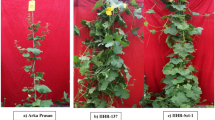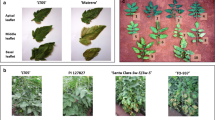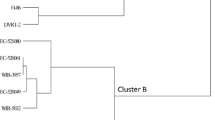Abstract
Protocols elaborated with the objective of achieving valuable material for selection procedure of variants with virusresistance traits in tomato genotypes are presented. Preliminary results are demonstrated in the domain of testing for variability in somaclones obtained through indirect adventitous organogenesis initiated on leaf explants of cultivated tomato (Lycopersicon esculentum Mill.). Somaclones were grown in greenhouse conditions and variation of their symptoms upon infection with tomato mosaic (ToMV) or cucumber mosaic (CMV) respectively was observed. Tests for resistance to the local isolates of the above cited viruses were performed using enzyme linked immunosorbent assay and back inoculation onto diagnostic plants. Screening data are presented. Desirable variants were selected from cultivars ‘Moneymaker’, ‘Potentat’ and ‘Rutgers’. Some of the ‘Moneymaker’ somaclones exhibited increased tolerance to cucumber mosaic virus, a few seemed to be even fully resistant though most were susceptible as donor plants. The most favourable somaclonal lines are actually further tested and monitored for changes in horticultural characteristics. The described procedure of searching for resistance trait in specific pathogen-free (SPF) plants regenerated from infected tissue looks promising and thus can serve as aid in attaining appropriate objectives of breeding programme.
Additionaly experiments were initiated to obtain somaclones from cultivars ‘Beta’, ‘Krakus’ and Stevens Rodade hybrid via regeneration of isolated protoplasts. To this end the callus stage was obtained from all donors.
Similar content being viewed by others
Abbreviations
- BA:
-
6-benzylaminopurine
- MES:
-
2-[N-Morpholino]ethane-sulfonic acid
- CMV:
-
cucumber mosaic virus
- ToMV:
-
tomato mosaic virus
- DAS ELISA:
-
double antibody sandwich procedure of enzyme-linked immunosorbent assay
- SPF plants:
-
specific pathogen-free plants
References
Bajaj Y.P.S. 1994. Somatic hybridization in crop improvement. In: Biotechnology in Agriculture and Forestry. Springer-Verlag, Berlin: 501–533
Barden K.A. Schiller Smith S. and H.H. Murakishi. 1986. Regeneration and screening of tomato somaclones for resistance to tobacco mosaic virus. Plant Science 45: 209–213
Beachy R.N. 1997. Mechanisms and applications of pathogen-derived resistance in transgenic plants. Curr. Opin. in Biotechnol. 8: 215–220
Bednarek J., Czuber B., Maj Z., Kobyłko . 1983. Identification of Tobacco Mosaic Virus races isolated from two species of the winter cherry (Physalis) and the susceptibility to infection by the former of some cultivars of the field tomato (Lycopersicon esculentum Mill.). Acta Agraria et Silv. Series Agraria Vol. XXII: 3–18
Bobisud C.A., Martin S.P., Sekioka T.T. 1996. Field testing bacterial wilt-resistant tomato somaclones. Jour. Amer. Soc. Hort. Scien. 121: 3
Bogani P., Simoni A., Bettini P., Mugnai M., Pellegrini M.G. and M. Buiatti. 1995. Genome flux in tomato auto- and auxo-trophic cell clones cultured in different auxin/cytokinin equilibria. I. DNA multiplicity and metylation levels. Genome 38: 902–912
Bogani P., Simoni A., Lio’ P., Scialpi A. and Buiatti M. 1996. Genome flux in tomato cell clones cultured in vitro in different physiological equilibria. II. A RAPD analysis of variability. Genome 39: 846–853
Bouman H., de Klerk G.J. 1997. Somaclonal variation. In: Biotechnology of ornamental plants. CAB International R.L. Geneve, J.E. Preece and S.A. Merkle eds.: 165–183
Buiatti M., Simeti C., Vannini S., Marcheschi G., Scala A., Bettini P., Bogani P. and Pellegrini M.G. 1987. Isolation of tomato cell lines with altered response to Fusarium cell wall components. T.A.G. 75: 37–40
Coyne D.P. 1995. Classical and Molecular Approaches to Breeding Horticultural Plants for Disease Resistance: Introduction to the Colloquium. Hort. Science 30/3: 448–477
De Kłerk G.J. 1990. How to measure somaclonal variation. Acta Bot. Neerl. 39: 129–144
Dempsey M., Silva H., Klessig D. 1998. Engineering disease and pest resistance in plants. Trends in Microbiol.: 6/2: 54–61
De Vries R.M., Stephens C.T., De Vries R.M. 1997. Response of first generation tomato somaclone progeny to Clavibacter michiganensis subsp. michiganensis. Plant Scien. Limerick. 126: 69–77
Fitchen J.H., Beachy R.N. 1993. Genetically engineered protection against viruses in transgenic plants. Annu. Rev. Microbiol.: 47: 739–763
Gamborg O.L., Miller R.A., Ojima K. 1968. Nutrient requirements of suspension cultures og soybean root cells. Experim. Cell Research 50:151–158
Grunewaldt J., Dunemann F. 1991. Variation and Selection in vitro. Gartenbauwissenschaft 56/1: 1–5
Guardiola M.L., Bettini P., Bogani P., Pellegrini M.G., Storti E., Bittini P. and Buiatti M. 1994. Modification of competence for in vitro response to Fusarium oxysporum in tomato cells. I. Selection from a susceptible cultivar for high and low polysaccharide content. T.A.G. 87: 998–995
Gartner U. 1992. Protoplastenkultur bei Tomate (Lycopersicon) unter besonderer Berucksichtidung metodischer Aspekte (Ubersichtsarbeit). Biologisches-Zentralbl. 111/1:1–20
Hille J., Zabel P., Koornneef M., Kaloo G. 1991. Genetic transformation of tomato and prospects for gene transfer. In: Genetic improvement of tomato. Monographs on Theoretical and Applied Genetics. Vol. 14, G. Kaloo ed. Springer-Verlag, Berlin Heidelberg New York: 283–291
Hossain M., Imanishi S. Egashira H. 1995. An improvement of tomato protoplast culture for rapid plant regeneration. Plant Cell Tiss. & Organ Cult. 42: 141–146
Hulanicka M.D., Zagórski-Ostoja W., Pałucha A. 1997. Non-conventional strategies to protect plants against viral infections. In: Zesz. Nauk. A.R. w Krakowie Nr 318 zesz. 50: 119–126
Hull R. 1994. Resistance to plant viruses: Obtaining genes by non-conventional approaches. Euphyt. 75: 195–205
Ingram D.S. 1973. Growth of Plant Parasites in Tissue Culture. In: Plant Tissue and Cell Culture., H.E. Street ed., Blackwell Scien. Publ. Oxford: 392–432
Ingram D.S. 1976. Growth of Biotrophic Parasites in Tissue Culture. In: Physiological Plant Pathology., R. Heitefuss & P.H. Williams eds., Springer-Verlag, Berlin, Heidelberg, New York: 473–759
Karp A. 1991. On the current understanding of somaclonal variation. Oxford Surveys Plant Mol. Cell biol. 7: 1–58
Kao K.N., Michayluk M.R. 1980. Plant regeneration from mesophyll protoplasts of alfa-alfa. Zeitschrift fur Pflanzenphysiol. 96: 135–141
Kobyłko T. 1996. Choroby wirusowe funkii (Hosta Tratt.) Zeszyty Naukowe AR w Krakowie, Rozpr. Nr 207
Kuźniak E. 1997. The use of in vitro cultures to study biotic stress induced plant defense reactions. Post. Biol. Kom. 24/4: 403–416
Larkin P.J., Scowcroft W.R. 1981. Somaclonal variation — a novel source of variability from cell cultures for plant improvement. T.A.G. 60: 197–214
Lech M., Pindel A., Miczyński K. 1997. Plant regeneration from protoplasts obtained from mesophyll leaf tissue of Lycopersicon glandulosum C. H. Mull. Acta Biol. Cracoviensia, Series Botanica 39: 51–54
Lefrancois C., Chupeau Y., Bourgin J.P. 1991. Toward cybridization in Lycopersicon species. Physiol. Plant. 82: 1, A38
Lefrancois C., Chupeau Y. 1993. Standard conditions for plant regeneration from leaf protoplasts of several Lycopersicon species. Journ. Plant Physiol. 141: 629–632
Loebenstein G. 1972. Inhibition, Interference and Acquired Resistance During Infection. In: Principles and Techniques in Plant Virology. C.I. Cado & H.O. Agrawal eds., Van Nostrand Reinhold Company, London, Toronto, Melbourne: 32–61
Lukyanenko A.N. 1991. Disease resistance in tomato. In: Genetic improvement of tomato. Monographs on Theoretical and Applied Genetics. Vol. 14, G. Kallo ed., Springer-Verlag, Belin, Heidelberg, New York: 99–119
Mori K., Hosokawa D. 1977. Localization of viruses in apical meristems and production of cirus-free plants by means of meristem and tissue culture. Acta Hortic. 78: 389–397
Mori K., Hosokawa D., Yamashita T. 1982. Regeneration of virus-free plants from protoplasts isolated from dark-green areas of tobacco mosaic virus-infected tobacco leaves. Proc. Vth Intl. Cong. Plant Tissue & Cell Cult.: 803–804
Murashige T. 1978. The impact of Plant Tissue Culture on Agriculture. In: Frontiers of Plant Tissue Culture. T.A. Thorpe ed. Economy Bookbindery Co. Ltd., Calgary: 15–26
Murashige T., Skoog F. 1962. A revised medium for rapid growth and bioassays with tobacco tissue culture. Physiol. Plant. 15:473–479
Niemirowicz-Szczytt K., Bartoszewski G. 1997. Ekspresja transgenów w genomie roślinnym. In: Zesz. Nauk. A.R. w Krakowie Nr 318 zesz. 50: 111–116
Pavlica M., Papes D., Franekic J and Nagy B. 1992. Effect of benzyladenine on procaryotic and eukaryotic cels. Mutation Research 281: 277–282
Pindel A., Lech M., Miczyński K. 1998. Regeneration of leaf mesophyl protoplasts from Lycopersicon glandulosum, L. peruvianum and L. esculentum Stevens Rodade hybrid. Acta Biol. Cracoviensia, Series Botanica 40: 41–46
Sakata Y., Nishio T., Narikawa T., Monma S. 1991. Cold and disease resistance of somatic hybrids between tomato (Lycopersicon esculentum) and L. peruvianum. Journ. Jap. Soc. Hort. Scie. 60: 329–335
Sakomoto K., Taguchi T. 1991. Regeneration of intergeneric somatic hybrid plants between Lycopersicon esculentum and Solanum muricatum. T.A.G. 81/4: 509–513
Schiller-Smith S., Murakishi H.H. 1993. Restricted virus multiplication and movement of tomato mosaic virus in resistant tomato somaclones. Plant Science 89: 113–122
Smulders M.J.M., Rus-Kortekaas W., Gilissen L.J,W. 1995. Natural variation in patterns of polysomaty among individual tomato plants and their regenerated progeny. Plant Sci. 106: 129–139
Storti E., Bogani P., Bettini P., Bonzi Morassi L., Pellegrini M.G., Matteo M., Simeti C. and Buiatti M. 1989. The pleiotropic phenotype of tomato cells selected for altered response to Fusarium oxysporum f. sp. lycopersici cell wall components. T.A.G. 78: 689–695
Storti E., Latil C., Salti S., Bettini P., Bogani P., Pellegrini M.G., Simeti C., Molnar A. and Buiatti M. 1992. The in vitro physiological phenotype of tomato resistance to Fusarium oxysporum f. sp. lycopersici. T.A.G. 84: 123–128
Sturtevant A.P., Beachy R.N., Hiatt A. 1993. Virus resistance in transgenic plants: coat protein-mediated resistance. In: Transgenic plants: Fundamentals and Applications. M. Dekker ed. New York: 93–112
Tan M.M.C., Rietveld E.M., van Marrevijk G.A., Kool A.J. 1987. Regeneration of mesophyll protoplasts of tomato cultivars (L. esculentum). Factors important for efficient protoplast culture and plant regeneration. Plant Cell Rep. 6: 172–175
Toyoda H., Horikoshi K., Chatani K., Shimizu K., Ochui S. 1990. Production of virus resistant plants through tissue culture. Abstr. VIIth Int. Cong. Plant Tissue & Cell Culture. Amsterdam
Walkey D.G.A. 1978. in vitro methods for virus elimination. In: Frontiers of Plant Tissue Culture. T.A. Thorpe ed. Economy Bookbindery Co. Ltd., Calgary: 245–254
Watterson J.C. 1994. Diseases. In: The tomato crop. A scientific basis for improvement. J.G. Atherton, J. Rudich eds., Chapman & Hall, Cambridge: 443–484
Wolters A.M., Jacobsen E., O’Connel M., Bonnema G., Ramulu K., de Jong H., Schoenmakers H., Wijbrandi J., Koornneef M. 1994. Somatic hybridization as a tool for tomato breeding. Euph. 79: 265–277
Zhuk I.P. 1993. Resistance of tomato somaclones to tobacco mosaic virus. Microbiolog. Zhurnal 55: 41–46
Zhuk I.P. 1994. Breeding TMV-resistant tomato somatic clones. Russian Agricult. Sciences No. 5: 5–6
Zhuk I.P. 1997. The stability to tobacco mosaic virus in the progeny of virus-resistant tomato somaclones. Russian Agricult. Sciences No. 8: 9–14
Zhuk I.P. 1998. Production of tomato clones resistant to TMV using somaclonal variability. Microbiolog. Zhurnal 60: 38–42.
Author information
Authors and Affiliations
Rights and permissions
About this article
Cite this article
Hanus-Fajerska, E., Lech, M., Pindel, A. et al. Selection for virus resistance in tomato exposed to tissue culture procedures. Acta Physiol Plant 22, 317–324 (2000). https://doi.org/10.1007/s11738-000-0045-y
Issue Date:
DOI: https://doi.org/10.1007/s11738-000-0045-y




